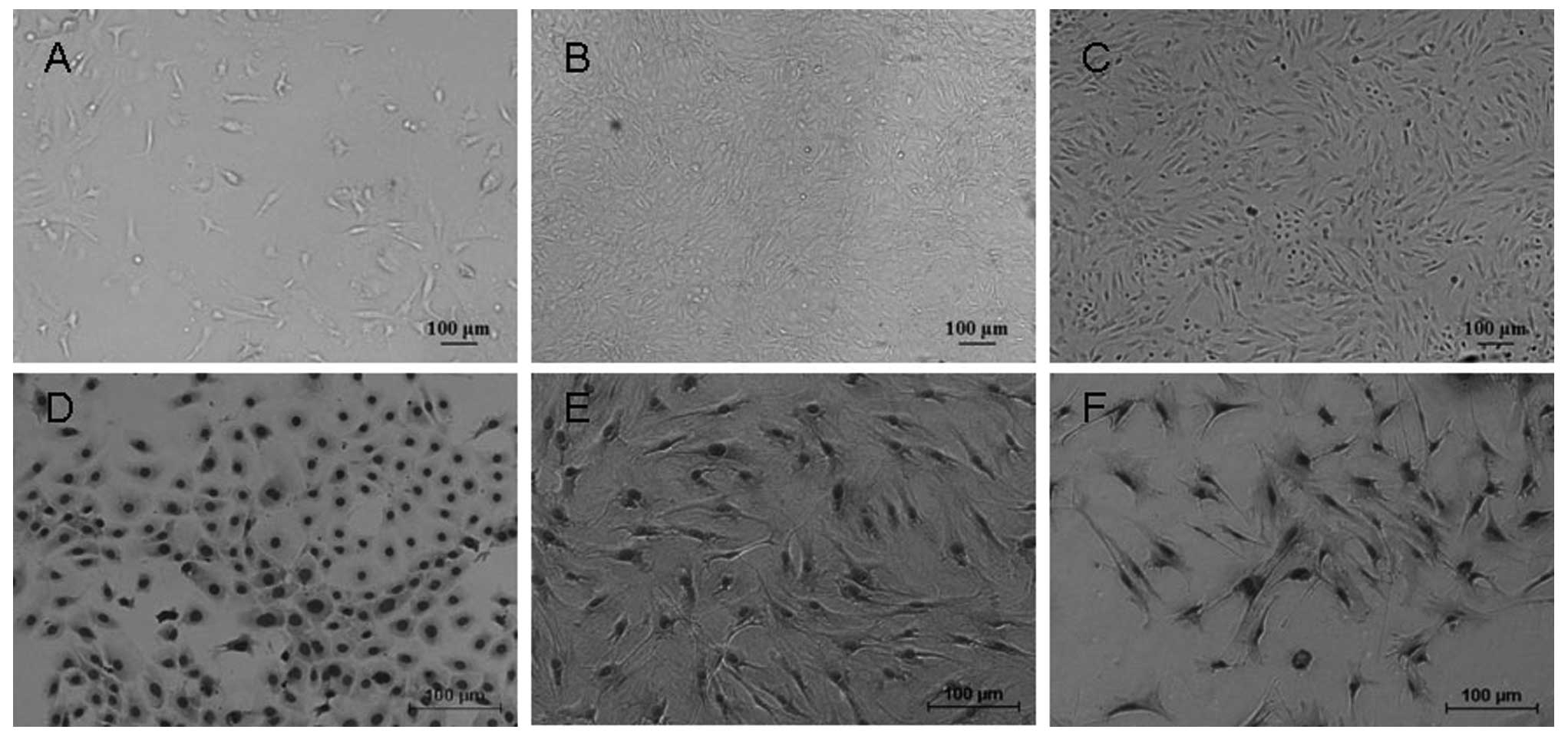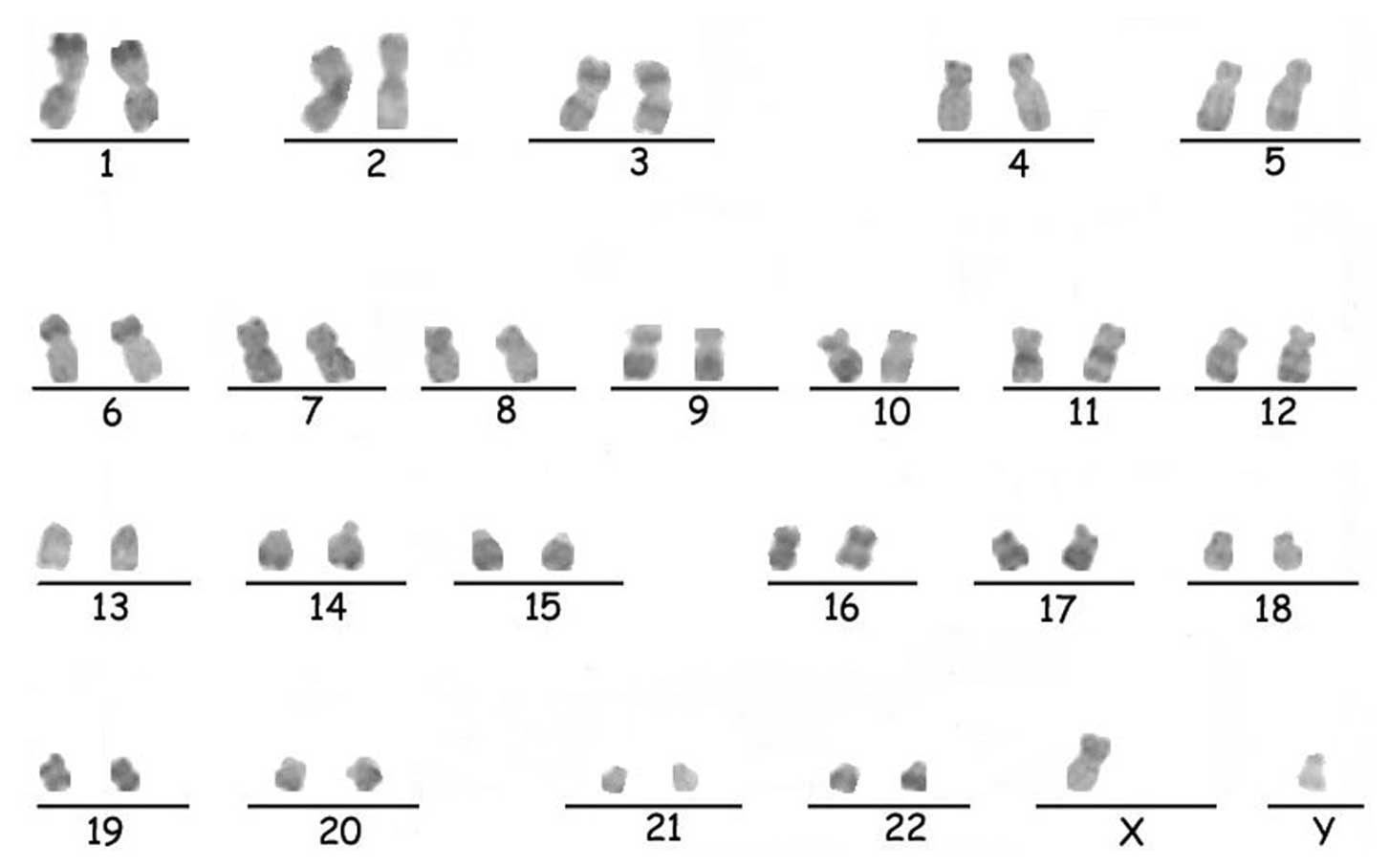|
1
|
Thomson JA, Itskovitz-Eldor J, Shapiro SS,
et al: Embryonic stem cell lines derived from human blastocysts.
Science. 282:1145–1147. 1998. View Article : Google Scholar : PubMed/NCBI
|
|
2
|
Niwa H: How is pluripotency determined and
maintained? Development. 134:635–646. 2007. View Article : Google Scholar : PubMed/NCBI
|
|
3
|
Reubinoff BE, Pera MF, Fong CY, Trounson A
and Bongso A: Embryonic stem cell lines from human blastocysts:
somatic differentiation in vitro. Nat Biotechnol. 18:399–404. 2000.
View Article : Google Scholar : PubMed/NCBI
|
|
4
|
Xu C, Inokuma MS, Denham J, et al:
Feeder-free growth of undifferentiated human embryonic stem cells.
Nat Biotechnol. 19:971–974. 2001. View Article : Google Scholar : PubMed/NCBI
|
|
5
|
Carpenter MK, Rosler ES, Fisk GJ, et al:
Properties of four human embryonic stem cell lines maintained in a
feeder-free culture system. Dev Dyn. 229:243–258. 2004. View Article : Google Scholar : PubMed/NCBI
|
|
6
|
Rosler ES, Fisk GJ, Ares X, et al:
Long-term culture of human embryonic stem cells in feeder-free
conditions. Dev Dyn. 229:259–274. 2004. View Article : Google Scholar : PubMed/NCBI
|
|
7
|
Levenstein ME, Ludwig TE, Xu RH, et al:
Basic fibroblast growth factor support of human embryonic stem cell
self-renewal. Stem Cells. 24:568–574. 2006. View Article : Google Scholar : PubMed/NCBI
|
|
8
|
Saxena S, Hanwate M, Deb K, Sharma V and
Totey S: FGF2 secreting human fibroblast feeder cells: a novel
culture system for human embryonic stem cells. Mol Reprod Dev.
75:1523–1532. 2008. View Article : Google Scholar : PubMed/NCBI
|
|
9
|
Wang G, Zhang H, Zhao Y, et al: Noggin and
bFGF cooperate to maintain the pluripotency of human embryonic stem
cells in the absence of feeder layers. Biochem Biophys Res Commun.
330:934–942. 2005. View Article : Google Scholar : PubMed/NCBI
|
|
10
|
Park Y, Kim JH, Lee SJ, et al: Human
feeder cells can support the undifferentiated growth of human and
mouse embryonic stem cells using their own basic fibroblast growth
factors. Stem Cells Dev. 20:1901–1910. 2011. View Article : Google Scholar : PubMed/NCBI
|
|
11
|
Xu RH, Peck RM, Li DS, Feng X, Ludwig T
and Thomson JA: Basic FGF and suppression of BMP signaling sustain
undifferentiated proliferation of human ES cells. Nat Methods.
2:185–190. 2005. View
Article : Google Scholar : PubMed/NCBI
|
|
12
|
Lim JW and Bodnar A: Proteome analysis of
conditioned medium from mouse embryonic fibroblast feeder layers
which support the growth of human embryonic stem cells. Proteomics.
2:1187–1203. 2002. View Article : Google Scholar : PubMed/NCBI
|
|
13
|
Cai J, Chen J, Liu Y, et al: Assessing
self-renewal and differentiation in human embryonic stem cell
lines. Stem Cells. 24:516–530. 2006. View Article : Google Scholar : PubMed/NCBI
|
|
14
|
Chin AC, Fong WJ, Goh LT, Philp R, Oh SK
and Choo AB: Identification of proteins from feeder conditioned
medium that support human embryonic stem cells. J Biotechnol.
130:320–328. 2007. View Article : Google Scholar : PubMed/NCBI
|
|
15
|
Lin S and Talbot P: Methods for culturing
mouse and human embryonic stem cells. Methods Mol Biol. 690:31–56.
2011. View Article : Google Scholar : PubMed/NCBI
|
|
16
|
Hu J-B, Ma Q-H and Hu S-Q: Preparation and
biological characteristics of feeder cells for human embryonic stem
cells. J Clin Rehabil Tissue Eng Res. 15:4233–4266. 2011.
|
|
17
|
Li C, Yang Y, Lu X, et al: Efficient
derivation of Chinese human embryonic stem cell lines from frozen
embryos. In Vitro Cell Dev Biol Anim. 46:186–191. 2010. View Article : Google Scholar : PubMed/NCBI
|
|
18
|
Amit M, Margulets V, Segev H, et al: Human
feeder layers for human embryonic stem cells. Biol Reprod.
68:2150–2156. 2003. View Article : Google Scholar : PubMed/NCBI
|
|
19
|
Hovatta O, Mikkola M, Gertow K, et al: A
culture system using human foreskin fibroblasts as feeder cells
allows production of human embryonic stem cells. Hum Reprod.
18:1404–1409. 2003. View Article : Google Scholar : PubMed/NCBI
|
|
20
|
Meng G, Liu S, Krawetz R, Chan M, Chernos
J and Rancourt DE: A novel method for generating xeno-free human
feeder cells for human embryonic stem cell culture. Stem Cells Dev.
17:413–422. 2008. View Article : Google Scholar : PubMed/NCBI
|
|
21
|
Cheng L, Hammond H, Ye Z, Zhan X and
Dravid G: Human adult marrow cells support prolonged expansion of
human embryonic stem cells in culture. Stem Cells. 21:131–142.
2003. View Article : Google Scholar : PubMed/NCBI
|
|
22
|
Richards M, Fong CY, Chan WK, Wong PC and
Bongso A: Human feeders support prolonged undifferentiated growth
of human inner cell masses and embryonic stem cells. Nat
Biotechnol. 20:933–936. 2002. View
Article : Google Scholar : PubMed/NCBI
|
|
23
|
Richards M, Tan S, Fong CY, Biswas A, Chan
WK and Bongso A: Comparative evaluation of various human feeders
for prolonged undifferentiated growth of human embryonic stem
cells. Stem Cells. 21:546–556. 2003. View Article : Google Scholar : PubMed/NCBI
|
|
24
|
Lee JB, Lee JE, Park JH, et al:
Establishment and maintenance of human embryonic stem cell lines on
human feeder cells derived from uterine endometrium under
serum-free condition. Biol Reprod. 72:42–49. 2005. View Article : Google Scholar : PubMed/NCBI
|
|
25
|
Lee JB, Song JM, Lee JE, et al: Available
human feeder cells for the maintenance of human embryonic stem
cells. Reproduction. 128:727–735. 2004. View Article : Google Scholar : PubMed/NCBI
|
|
26
|
Zhang K, Cai Z, Li Y, et al: Utilization
of human amniotic mesenchymal cells as feeder layers to sustain
propagation of human embryonic stem cells in the undifferentiated
state. Cell Reprogram. 13:281–288. 2011. View Article : Google Scholar : PubMed/NCBI
|
|
27
|
Lai D, Cheng W, Liu T, Jiang L and Huang
Q: Use of human amnion epithelial cells as a feeder layer to
support undifferentiated growth of mouse embryonic stem cells.
Cloning Stem Cells. 11:331–340. 2009. View Article : Google Scholar : PubMed/NCBI
|
|
28
|
Liu T, Cheng W, Guo L, et al: Human
amniotic epithelial cell feeder layers maintain mouse embryonic
stem cell pluripotency via epigenetic regulation of the c-Myc
promoter. Acta Biochim Biophys Sin (Shanghai). 42:109–115. 2010.
View Article : Google Scholar : PubMed/NCBI
|
|
29
|
Park Y, Choi IY, Lee SJ, et al:
Undifferentiated propagation of the human embryonic stem cell
lines, H1 and HSF6, on human placenta-derived feeder cells without
basic fibroblast growth factor supplementation. Stem Cells Dev.
19:1713–1722. 2010. View Article : Google Scholar
|
|
30
|
Xi J, Wang Y, Zhang P, et al: Human fetal
liver stromal cells that overexpress bFGF support growth and
maintenance of human embryonic stem cells. PLoS One. 5:e144572010.
View Article : Google Scholar : PubMed/NCBI
|
|
31
|
Stojkovic P, Lako M, Stewart R, et al: An
autogeneic feeder cell system that efficiently supports growth of
undifferentiated human embryonic stem cells. Stem Cells.
23:306–314. 2005. View Article : Google Scholar : PubMed/NCBI
|
|
32
|
Wang Q, Fang ZF, Jin F, Lu Y, Gai H and
Sheng HZ: Derivation and growing human embryonic stem cells on
feeders derived from themselves. Stem Cells. 23:1221–1227. 2005.
View Article : Google Scholar : PubMed/NCBI
|
|
33
|
Li W, Yamashita H, Hattori F, et al:
Simple autogeneic feeder cell preparation for pluripotent stem
cells. Stem Cell Res. 6:83–89. 2011. View Article : Google Scholar : PubMed/NCBI
|
|
34
|
Choo A, Ngo AS, Ding V, Oh S and Kiang LS:
Autogeneic feeders for the culture of undifferentiated human
embryonic stem cells in feeder and feeder-free conditions. Methods
Cell Biol. 86:15–28. 2008. View Article : Google Scholar : PubMed/NCBI
|
|
35
|
Park JH, Kim SJ, Oh EJ, et al:
Establishment and maintenance of human embryonic stem cells on STO,
a permanently growing cell line. Biol Reprod. 69:2007–2014. 2003.
View Article : Google Scholar : PubMed/NCBI
|
|
36
|
Park SP, Lee YJ, Lee KS, et al:
Establishment of human embryonic stem cell lines from frozen-thawed
blastocysts using STO cell feeder layers. Hum Reprod. 19:676–684.
2004. View Article : Google Scholar : PubMed/NCBI
|
|
37
|
Xu C, Jiang J, Sottile V, McWhir J,
Lebkowski J and Carpenter MK: Immortalized fibroblast-like cells
derived from human embryonic stem cells support undifferentiated
cell growth. Stem Cells. 22:972–980. 2004. View Article : Google Scholar : PubMed/NCBI
|
|
38
|
Cai L, Ye Z, Zhou BY, Mali P, Zhou C and
Cheng L: Promoting human embryonic stem cell renewal or
differentiation by modulating Wnt signal and culture conditions.
Cell Res. 17:62–72. 2007. View Article : Google Scholar : PubMed/NCBI
|
|
39
|
Unger C, Gao S, Cohen M, et al:
Immortalized human skin fibroblast feeder cells support growth and
maintenance of both human embryonic and induced pluripotent stem
cells. Hum Reprod. 24:2567–2581. 2009. View Article : Google Scholar : PubMed/NCBI
|
|
40
|
Hernandez D, Ruban L and Mason C:
Feeder-free culture of human embryonic stem cells for scalable
expansion in a reproducible manner. Stem Cells Dev. 20:1089–1098.
2011. View Article : Google Scholar : PubMed/NCBI
|
|
41
|
Thomas RJ, Anderson D, Chandra A, et al:
Automated, scalable culture of human embryonic stem cells in
feeder-free conditions. Biotechnol Bioeng. 102:1636–1644. 2009.
View Article : Google Scholar : PubMed/NCBI
|
|
42
|
Rodin S, Domogatskaya A, Strom S, et al:
Long-term self-renewal of human pluripotent stem cells on human
recombinant laminin-511. Nat Biotechnol. 28:611–615. 2010.
View Article : Google Scholar : PubMed/NCBI
|
|
43
|
Escobedo-Lucea C and Stojkovic M: Growth
of human embryonic stem cells using derivates of human fibroblasts.
Methods Mol Biol. 584:55–69. 2010. View Article : Google Scholar : PubMed/NCBI
|
|
44
|
Larijani MR, Seifinejad A, Pournasr B, et
al: Long-term maintenance of undifferentiated human embryonic and
induced pluripotent stem cells in suspension. Stem Cells Dev.
20:1911–1923. 2011. View Article : Google Scholar
|
|
45
|
Rajala K, Hakala H, Panula S, et al:
Testing of nine different xeno-free culture media for human
embryonic stem cell cultures. Hum Reprod. 22:1231–1238. 2007.
View Article : Google Scholar : PubMed/NCBI
|
|
46
|
Vazin T and Freed WJ: Human embryonic stem
cells: derivation, culture, and differentiation: a review. Restor
Neurol Neurosci. 28:589–603. 2010.PubMed/NCBI
|

















